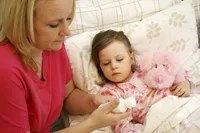My son’s daycare called to let us know that a child there was sick with meningitis. I thought this was a pretty rare disease. What are the symptoms?
There are two forms of meningitis, caused by either a virus (viral meningitis) or bacteria (bacterial meningitis). Both forms of the disease cause inflammation of the tissue that covers the brain and the spinal cord (the meninges). The two share common symptoms: headache, high fever and a stiff neck. Other symptoms include nausea and vomiting, discomfort when looking into bright lights, and confusion or irritability. What the two types of meningitis do not have in common, however, is their severity.
Bacterial meningitis is very serious. It can be fatal and should be treated as soon as possible. Viral meningitis is not fatal and usually runs its course in 7-10 days.
The difference in the two types is the underlying cause. When we hear about sudden deaths from this disease, the culprit is usually one of the bacterial infections, either pneumococcal meningitis or meningicoccal meningitis. Before the 1990s, Haemophilus influenzae type b (Hib) was by far the leading cause of bacterial meningitis in children; however, the Hib vaccine is now given to toddlers as part of their routine childhood immunizations. Because of this vaccine, bacterial meningitis in children is now very uncommon.

Because the symptoms of viral and bacterial meningitis are so similar, it is extremely important for your physician to determine which form of the disease is present. With bacterial meningitis, treatment using the proper type of antibiotics is essential. It is also very important to determine whether anyone has been in close contact with someone who has bacterial meningitis. If so, those individuals can be treated with antibiotics to prevent them from getting it as well. Diagnosing either type of the disease involves taking a sample of spinal fluid and examining the fluid for the presence of bacteria.
Viral meningitis, although not fatal, does not respond to treatment with antibiotics. It’s a milder form of the disease and usually people with normal, healthy immune systems recover on their own. Bed rest, fluids, and pain and fever medications are the best treatments. This type of meningitis is contagious; people contract it in the same way they get the flu or a cold, from hand-to-face contact. The reason it often occurs in day-care centers or schools is that it can also be transmitted by contact with infected feces.
Because viral meningitis is much milder than bacterial, many people who become infected develop mild symptoms or no symptoms at all. However, they can still transmit the virus. The best way to prevent either getting or passing the virus is to observe basic hygienic guidelines such as washing your hands frequently. If you work in an institution like a day-care center or pre-school, make sure that surfaces are regularly cleaned with disinfectant.
Anyone suffering from the symptoms associated with meningitis should see a physician immediately. In addition, people who think they may have been exposed to the disease should consult with their physician.





















